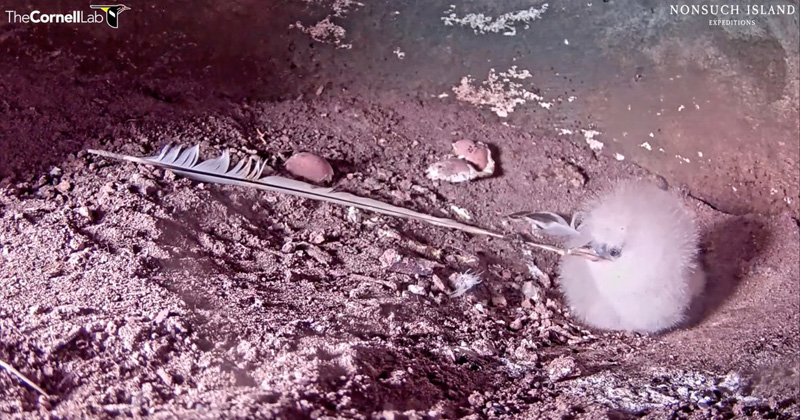Longtail Tropicbird Cam Now Broadcasting Live
The Longtail Tropicbird Cam is now broadcasting live from Nonsuch Island.
A spokesperson said, “The Longtail Tropicbird Cam is now broadcasting live from Nonsuch Island and can be viewed here.
“Now in its fourth year, it is a collaboration between Nonsuch Expeditions, the Department of the Environment and Natural Resources and the Cornell Lab of Ornithology.
“The live stream will appear black at night as this cam does not operate with infrared lights [and Tropicbirds only sleep at night, unlike the Cahows], however users can scroll back in the timeline to view daylight portions.
“This year’s chick hatched on April 24th [one of the earliest that Jeremy has logged in 22 years] and as of its first health check on the 29th was up to 55 grams, see the first health check video.
“Unlike the Cahows, which leave their chick alone within hours of hatching, Tropicbirds generally stay with their chick off and on for the first few weeks to protect it from predators and other prospecting Tropicbirds that are know to kill young chicks in an attempt to take over the nest.
“Accordingly viewers will see the parents coming in and out during the day, though they usually leave the chick alone just before sunrise to go out to sea to feed.
“In addition to the Cahow, this seabird shares Nonsuch Island as nesting habitat: The White-tailed Tropicbird is Bermuda’s only remaining, locally common seabird, with over 3500 breeding pairs nesting on Bermuda during the spring and summer months.
“Of these, over 600 breeding pairs nest on the Castle Islands Nature Reserve, including about 200 pairs nesting on Nonsuch Island.
“On Nonsuch, about 70 artificial igloo nests have been installed to replace natural cliff cavities which have been destroyed by hurricane erosion and cliff falls during hurricanes over the last 20 years.
“One of these nests, along the stairway leading up from the Nonsuch dock, has the Tropicbird / Longtail-Cam installed so that we can now follow the little-known “nest life” of this difficult to study species, which is generally more aggressive than the more laid-back Cahow.
“The White-tailed Tropicbird is almost always known in Bermuda has the Longtail because of its distinctive tail feathers. This species is well known and much loved locally. Longtails are relatively large birds; adults can measure up to 30 inches [76cm] including the tail feathers, with wingspans up to 3ft [1m].
“The feathers are pure white, with diagonal black bars across each wing. These bars form a V shape when the flying bird is viewed from above. The wing tips are also black and there is a black band through the eye. The distinctive tail is composed of two extremely long feathers, surrounded by other short ones, and is used by the birds during the tail-touching courtship display, when both birds fly in close formation, one above the other, and try to bring the tail feathers into contact.
“Contrary to widespread local belief, the birds do not mate in the air, but back in the privacy of the nest cavity. Occasionally Longtails are seen that have lost both of the long feathers. The Longtail’s sharp, pointed bill is yellow in young birds, and turns to orange.
“The webbed feet are dark. Juvenile Longtails are white with various thick black bars on their backs, and they do not yet have the long tail feathers.
“Learn more and watch the live stream video here.”
Read More About
Category: All, Environment, technology, Videos






